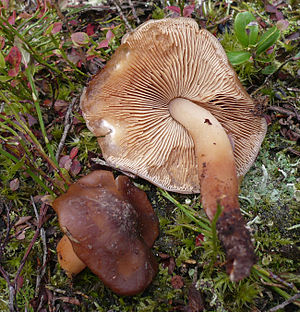Root cuttings
| Root cuttings | ||||||||||||
|---|---|---|---|---|---|---|---|---|---|---|---|---|

Thick-fleshed root carving |
||||||||||||
| Systematics | ||||||||||||
|
||||||||||||
| Scientific name | ||||||||||||
| Phaeocollybia | ||||||||||||
| R. Heim |
The root carvings ( Phaeocollybia ) are leaf mushrooms with a turnip habit and a root-like stem that extends deep into the ground. Their spore powder has the rust-brown color that is typical for veil relatives.
The type species is the thick-fleshed root carving ( Phaeocollybia lugubris ).
features
Macroscopic features
Root carvings usually form medium-sized fruit bodies with a turnip-like habit , which often have a pointed hunched hat and a more or less cartilaginous, often deep-rooted stalk ("pseudorhiza" = false root). The hat is dry, glabrous and smooth, when damp, however, greasy to slimy - even if sometimes only weakly - and hygrophan . The lamellas are attached to the stem or almost free. They are pale waxy in color or rarely purple-brown and take on a rust-brown color with age due to the spore powder. The velum is either missing or there are tires. The odor spectrum ranges from neutral to flour or radish-like to a clear bitter almond aroma.
Microscopic features
The hat skin of the root carvings consists of lying, thin, thread-like and mostly somewhat gelatinized hyphae . Buckles on the hyphae septa are present or absent. The lamellar trama is set up regularly. On the cutting edges there are thread-shaped, cylindrical or spindle-shaped cystids, often with a long neck and head-shaped end . In older fruit bodies, they are strongly bonded and therefore difficult to prepare. Elliptical, spindle-shaped or almond-shaped, rarely also lemon-shaped spores ripen on the basidia . They have a dotted to warty surface and apart from one type (inconspicuous there) have no apical germ pore . On the cortex of the false root sit tibiiform (= similar to the shin bone) caulocystids.
ecology
The species of the genus are considered to be root parasites bound to conifers, mostly spruce , but also hardwoods such as beech , oak and hornbeam .
distribution
The occurrence of the root carvings in Germany is concentrated in the areas south of the 52nd parallel, the federal states of Baden-Württemberg and Bavaria.
species
The genus of the root carvings ( Phaeocollybia ) consists of only a few species in Central Europe:
| German name | Scientific name | Author quote |
|---|---|---|
| Smallest root carving | Phaeocollybia arduennensis | Bon 1979 |
| Ocher red root carving | Phaeocollybia christinae | (Fries 1838) Heim 1931 |
| Orange-brown root carving | Phaeocollybia cidaris | (Fries 1838) Heim 1931 |
| Olive green root carving | Phaeocollybia festiva | (Fries 1838) Heim 1931 |
| Fire-red root carving | Phaeocollybia jennyae | (Karsten 1881) Romagnesi 1944 |
| Thick-fleshed root carving | Phaeocollybia lugubris | (Fries 1821) Heim 1931 |
swell
Individual evidence
- ↑ Roger Heim: Le genre Inocybe . In: Encyclopédie Mycologique 1. 1931. P. 70.
- ^ A b c Edmund Garnweidner, Peter Karasch, Andreas Kunze: Remarkable new finds from the genus Phaeocollybia in Bavaria . In: Mycologia Bavarica 11th 2010. pp. 15-28.
- ↑ a b German Josef Krieglsteiner , Andreas Gminder (ed.): Die Großpilze Baden-Württemberg . Volume 5: Mushrooms. Agarics III. Ulmer, Stuttgart 2010, ISBN 978-3-8001-3572-1 .
- ↑ Thomas Flammer: Mushroom Lexicon. Microscopy: Cell structures and cystides ( page no longer available , search in web archives ) Info: The link was automatically marked as defective. Please check the link according to the instructions and then remove this notice. (PDF; 1.1 MB). On: giftpilze.ch . October 24, 2010. Accessed May 7, 2011. (PDF; 924 kB)
- ↑ a b Erhard Ludwig: Pilzkompendium, vol. 1. Descriptions: The smaller genera of the macromycetes with lamellar hymenophore from the orders Agaricales, Boletales and Polyporales . IHW Verlag, Eching. 2001. ISBN 3-930167-43-3 .
- ^ AC Rinaldi, O. Comandini, TW Kuyper: Ectomycorrhizal fungal diversity: separating the wheat from the chaff . In: Fungal Diversity 33 (1). 2008. pp. 1-45. (PDF; 388 KB)
- ↑ Doris Laber: Supplement to "The European species of the genus Phaeocollybia and their occurrence in the southern Black Forest" . In: Zeitschrift für Mykologie 57 (1). 1991, p. 109.
- ↑ Eric Strittmatter: The genus Phaeocollybia . (No longer available online.) In: fungiworld.com. Mushroom Taxa Database. August 30, 2011, archived from the original on April 7, 2015 ; Retrieved July 9, 2012 . Info: The archive link was inserted automatically and has not yet been checked. Please check the original and archive link according to the instructions and then remove this notice.

